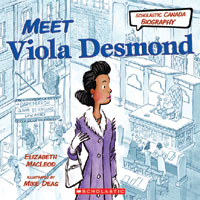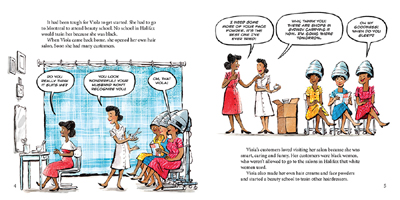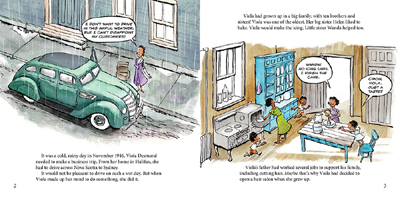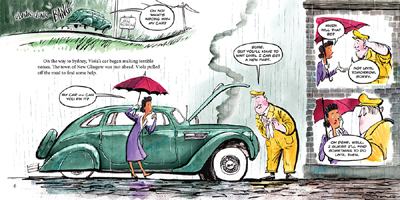| ________________
CM . . .
. Volume XXIV Number 39. . . .June 8, 2018

 |
Meet Viola Desmond. (Scholastic Canada Biography).
Elizabeth MacLeod. Illustrated by Mike Deas.
Toronto, ON: Scholastic Canada, 2018.
32 pp., hardcover, $14.99.
ISBN 978-1-4431-6387-3.
Subject Headings:
Desmond, Viola, 1914-1965-Juvenile literature.
Race discrimination-Nova Scotia-History-Juvenile literature.
Civil rights-Nova Scotia-History-Juvenile literature.
Black Canadians-Nova Scotia-Biography-Juvenile literature.
Biographies.
Kindergarten-grade 2 / Ages 5-7.
Review by Tanya Boudreau.
**** /4
|
| |
|

excerpt:
Viola had grown up in a big family, with ten brothers and sisters! Viola was one of the oldest. Her big sister Helen liked to bake. Viola would make the icing. Little sister Wanda helped too.
Viola’s father had worked several jobs to support his family, including cutting hair. Maybe that’s why Viola had decided to open a hair salon when she grew up.
It had been tough for Viola to get started. She had to go to Montreal to attend beauty school. No school in Halifax would train her because she was black.
 While visiting a New Glasgow, NS, movie theatre in 1946, Viola Desmond experienced racial discrimination. She bought a ticket to watch a movie downstairs but was forcefully removed by the police when she wouldn’t move to the balcony. She was ordered to pay a $26.00 fine (equivalent of $350.00 today). Although her husband thought she should accept the fact that black people “would always be treated badly”, Viola had her story published in the Clarion newspaper, a newspaper that was run by Black people. This biography continues Viola’s story with information about how the top court in Nova Scotia wouldn’t hear her case, and how, after Viola died in 1965, her sister Wanda shared Viola’s story with reporters, school-aged children and university students. While visiting a New Glasgow, NS, movie theatre in 1946, Viola Desmond experienced racial discrimination. She bought a ticket to watch a movie downstairs but was forcefully removed by the police when she wouldn’t move to the balcony. She was ordered to pay a $26.00 fine (equivalent of $350.00 today). Although her husband thought she should accept the fact that black people “would always be treated badly”, Viola had her story published in the Clarion newspaper, a newspaper that was run by Black people. This biography continues Viola’s story with information about how the top court in Nova Scotia wouldn’t hear her case, and how, after Viola died in 1965, her sister Wanda shared Viola’s story with reporters, school-aged children and university students.  The book ends with Wanda, on Viola’s behalf, accepting an apology made by Nova Scotia premier Darrell Dexter in 2010. Viola has since been recognized on postage stamps and the Canadian ten-dollar bill. The book ends with Wanda, on Viola’s behalf, accepting an apology made by Nova Scotia premier Darrell Dexter in 2010. Viola has since been recognized on postage stamps and the Canadian ten-dollar bill.
Viola’s story, told in a picture book format, includes speech bubbles which add bits of dialogue to the characters’ storyline, thereby helping the reader understand how they were feeling and thinking at the time. When Viola is put in jail, her thoughts appear in a speech bubble above her head: “I can’t believe I’m in jail! The way black people are treated is wrong.”
 The clothing, hair styles, cars, and vehicles change throughout the story to reflect the 1946 to 2018 timeline. Back material includes black and white and colour photographs of Viola and her sister Wanda. Children who are learning about racism, Canadian history, or civil rights would find this book useful and interesting. The story is fast paced, with dramatic, emotion-filled scenes. Meet Viola Desmond should be in libraries across Canada.
The clothing, hair styles, cars, and vehicles change throughout the story to reflect the 1946 to 2018 timeline. Back material includes black and white and colour photographs of Viola and her sister Wanda. Children who are learning about racism, Canadian history, or civil rights would find this book useful and interesting. The story is fast paced, with dramatic, emotion-filled scenes. Meet Viola Desmond should be in libraries across Canada.
Highly Recommended.
Tanya Boudreau is a librarian at the Cold Lake Public Library in Cold Lake, AB.

© CM Association
CC BY-NC-ND
Hosted by:
University of Manitoba
ISSN 1201-9364
|
This Creative Commons license allows you to download the review and share it with others as long as you credit the CM Association. You cannot change the review in any way or use it commercially.
Commercial use is available through a contract with the CM Association. This Creative Commons license allows publishers whose works are being reviewed to download and share said CM reviews provided you credit the CM Association. |
Next Review | Table of Contents for This Issue - June 8, 2018.
CM Home | Back Issues | Search | CM Archive | Profiles Archive
|

 While visiting a New Glasgow, NS, movie theatre in 1946, Viola Desmond experienced racial discrimination. She bought a ticket to watch a movie downstairs but was forcefully removed by the police when she wouldn’t move to the balcony. She was ordered to pay a $26.00 fine (equivalent of $350.00 today). Although her husband thought she should accept the fact that black people “would always be treated badly”, Viola had her story published in the Clarion newspaper, a newspaper that was run by Black people. This biography continues Viola’s story with information about how the top court in Nova Scotia wouldn’t hear her case, and how, after Viola died in 1965, her sister Wanda shared Viola’s story with reporters, school-aged children and university students.
While visiting a New Glasgow, NS, movie theatre in 1946, Viola Desmond experienced racial discrimination. She bought a ticket to watch a movie downstairs but was forcefully removed by the police when she wouldn’t move to the balcony. She was ordered to pay a $26.00 fine (equivalent of $350.00 today). Although her husband thought she should accept the fact that black people “would always be treated badly”, Viola had her story published in the Clarion newspaper, a newspaper that was run by Black people. This biography continues Viola’s story with information about how the top court in Nova Scotia wouldn’t hear her case, and how, after Viola died in 1965, her sister Wanda shared Viola’s story with reporters, school-aged children and university students.  The book ends with Wanda, on Viola’s behalf, accepting an apology made by Nova Scotia premier Darrell Dexter in 2010. Viola has since been recognized on postage stamps and the Canadian ten-dollar bill.
The book ends with Wanda, on Viola’s behalf, accepting an apology made by Nova Scotia premier Darrell Dexter in 2010. Viola has since been recognized on postage stamps and the Canadian ten-dollar bill.  The clothing, hair styles, cars, and vehicles change throughout the story to reflect the 1946 to 2018 timeline. Back material includes black and white and colour photographs of Viola and her sister Wanda. Children who are learning about racism, Canadian history, or civil rights would find this book useful and interesting. The story is fast paced, with dramatic, emotion-filled scenes. Meet Viola Desmond should be in libraries across Canada.
The clothing, hair styles, cars, and vehicles change throughout the story to reflect the 1946 to 2018 timeline. Back material includes black and white and colour photographs of Viola and her sister Wanda. Children who are learning about racism, Canadian history, or civil rights would find this book useful and interesting. The story is fast paced, with dramatic, emotion-filled scenes. Meet Viola Desmond should be in libraries across Canada.